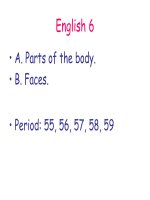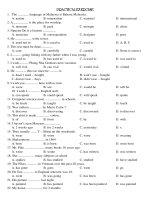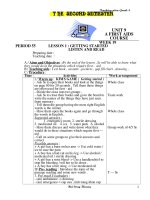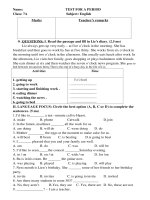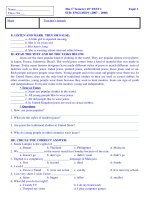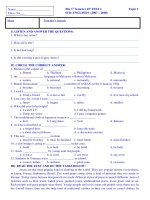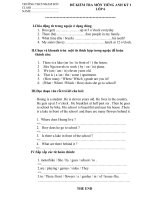AAMC MCAT test 9 a
Bạn đang xem bản rút gọn của tài liệu. Xem và tải ngay bản đầy đủ của tài liệu tại đây (225.76 KB, 91 trang )
9R SOLUTIONS FROM AAMC
Physical Sciences
1. 1.
A solution contains 0.1 M Mg2+(aq), 0.1 M Ca2+(aq), and 0.1 M Sr2+(aq). All
three ions can be precipitated if which two reagents are added to the solution?
A
)
Reagents 1 and 2
B
)
Reagents 1 and 3
Mg2+ can be precipitated from a solution of Reagent 1 only. Ca2+ can be
precipitated from a solution of reagents 3 or 4, and Sr2+ can be precipitated from a
solution of reagents 2, 3, or 4. All three ions can be precipitated from a solution
containing Reagent 1 and reagents 3 or 4. The ions will precipitate from a solution
containing reagents 1 and 3. Thus, B is the best answer.
C
D
)
Reagents 2 and 3
)
Reagents 2 and 4
Solution
Guess
2.
A test tube contains 2 mL of 0.1 M Ca2+(aq). A precipitate will most likely
form if which of the following reagents is added to the tube?
A
B
)
1.0 M HCl(aq)
)
1.0 M NaOH(aq)
)
1.0 M H2SO4(aq)
)
1.0 M Na2CO3(aq)
C
D
Ca2+ forms a precipitate when either Reagent 3, a solution of (NH4)2C2O4, or
Reagent 4, a solution of (NH4)2CO3, is added to the Ca(NO3)2 solution. A precipitate
would form when a solution of Na2CO3 is added. Na2CO3, like (NH4)2CO3, is a
source of CO32– and its addition would result in the formation of the insoluble
CaCO3. Thus, D is the best answer.
Solution
Guess
3.
The students added Reagent 2 to a test tube containing 0.1 M Ca2+(aq) and
0.1 M Sr2+(aq). Which of the following procedures will best enable the students to
recover a fairly pure sample of SrSO4(s) from this mixture?
A
)
the tube
Allowing the water to evaporate and collecting the solid that remains in
B
)
Pouring the mixture through a filter, collecting the insoluble substance,
and allowing the water to evaporate from the insoluble substance
When Reagent 2 is added to the Ca2+ solution, the resulting solution is clear. When
Reagent 2 is added to the Sr2+ solution, a white precipitate is generated. It follows
that after the addition of Reagent 2 to a solution containing Ca2+ and Sr2+, the
Ca2+ would remain in the solution and the Sr2+ would precipitate out as SrSO4. Pure
SrSO4 could be obtained by isolating the solid by filtration and allowing the water to
evaporate from the solid. Thus, B is the best answer.
C
)
Pouring the mixture through a filter, collecting the filtrate containing
the soluble substance, then allowing the water to evaporate from the filtrate
D
)
Adding Reagent 3, pouring the mixture through a filter, collecting the
filtrate containing the soluble substance, and allowing the water to evaporate from
the filtrate
Solution
Guess
4.
The information in Table 1 suggests that which of the following substances
has the smallest Ksp?
A
)
MgSO4
)
MgC2O4
)
CaSO4
)
CaC2O4
B
C
D
The smaller the Ksp of a substance, the lower the solubility of the substance. MgSO4,
MgC2O4, and CaSO4 all remain dissolved, but CaC2O4 does not. Therefore, CaC2O4
has the lowest solubility and the smallest Ksp. Thus, D is the best answer.
Solution
Guess
5.
A solution contains either Ca2+(aq) or Sr2+(aq). Which of the following
actions will best enable the students to identify the ion in the solution?
A
)
Performing a flame test
B
)
Adding Reagent 1
)
Adding Reagent 2
C
When Reagent 2 is added to the Ca2+ solution, the resulting solution is clear. When
Reagent 2 is added to the Sr2+ solution, a white precipitate forms. The students will
be able to determine which ion is present by adding Reagent 2. Thus, C is the best
answer.
D
)
Adding Reagent 3
Solution
Guess
6.
Which of the following graphs best illustrates how charge accumulates on the
plates of the capacitor after the switch is closed?
A
)
B
)
As time increases, charging must increase as well. Further, the charging of a
capacitor is an exponentially decreasing process that must reach a constant value
after a long time. The graph in B most clearly shows this behavior. Thus, B is the best
answer.
C
)
D
)
Solution
Guess
7.
If the speed of the charged particle described in the passage is increased by a
factor of 2, the electrical force on the particle will:
A
B
)
decrease by a factor of 2.
)
remain the same.
Electrical force depends on the particle’s charge and the strength of the electric field
experienced by the particle, not on the particle’s speed. Thus, B is the best answer.
C
D
)
increase by a factor of 2.
)
increase by a factor of 4.
Solution
Guess
8.
Making which of the following changes to a circuit element will increase the
capacitance of the capacitor described in the passage?
A
)
Replacing the 500-Ω resistor with a 250-Ω resistor
)
Replacing the 10-V battery with a 20-V battery
)
Increasing the separation of the capacitor plates
)
Increasing the area of the capacitor plates
B
C
D
Capacitance C depends on geometric factors only, and in the case of parallel plates,
C is proportional to the plate area and inversely proportional to the separation
distance of the plates. Thus, D is the best answer.
Solution
Guess
9.
A charged particle with a mass of m and a charge of q is injected midway
between the plates of a capacitor that has a uniform electric field of E. What is the
acceleration of this particle due to the electric field?
A
)
Eq/m
The force on the charge is qE and force is also ma. Setting qE = ma and solving for
acceleration a yields
Thus, A is the best answer.
B
C
)
Em/q
)
mq/E
)
Emq
D
Solution
Guess
10.
Another capacitor, identical to the original, is added in series to the circuit
described in the passage. Compared to the original circuit, the equivalent
capacitance of the new circuit is:
A
)
1/2 as great.
When in series, capacitors C1 and C2 add by the inverse rule
Therefore, if C1 = C2 = C, then
Thus, A is the best answer.
B
)
the same.
)
2 times as great.
)
4 times as great.
C
D
Solution
Guess
11.
Which of the following best describes the motion of a negatively charged
particle after it has been injected between the plates of a charged, parallel-plate
capacitor? (Note: Assume that the area between the plates is a vacuum.)
A
)
It moves with constant speed toward the positive plate.
)
It moves with constant speed toward the negative plate.
)
It accelerates toward the positive plate.
B
C
Opposites attract, so the negatively charged particle will move toward the positive
plate. Because there is a constant force qE on the particle, it will accelerate toward
the positive plate. Thus, C is the best answer.
D
)
It accelerates toward the negative plate.
Solution
Guess
12.
What type of intermolecular interaction can ETOH undergo with water that
MTBE can NOT?
A
)
van der Waals
)
Dipole–dipole
)
Hydrogen bonding
B
C
The –OH group in ETOH gives ETOH the capability of donating hydrogen bonds to
water. MTBE is incapable of donating hydrogen bonds to water. Thus, C is the best
answer.
D
)
Covalent bonding
Solution
Guess
13.
The formation of one mole of which oxygenate shown in Table 1 releases the
most energy?
A
B
)
ETOH
)
MTBE
)
ETBE
)
TAME
C
D
The formation of 1 mol of TAME gives off the most energy, 680 kJ. Thus, D is the best
answer.
Solution
Guess
14.
What are the coefficients for oxygen and carbon dioxide, respectively, if the equation
shown below is balanced?
1CH3OCH3(ℓ ) + ? O2(g) ® __ H2O(g) + ? CO2(g)
A
B
)
2 and 1
)
2 and 2
)
3 and 1
)
3 and 2
C
D
The six hydrogen atoms in CH3OCH3 on the left side of the equation must be
balanced by giving H2O on the right side of the equation a coefficient of 3. The two
carbon atoms in CH3OCH3 on the left side of the equation must be balanced by
giving CO2 on the right side of the equation a coefficient of 2. Now, the seven oxygen
atoms on the right side of the equation must be balanced by giving O2 on the left
side of the equation a coefficient of 3. Thus, D is the best answer.
Solution
Guess
15.
Which of the following nonoxygenated analogs of MTBE is most likely to mimic
MTBE in its antiknock properties?
A
)
C4H9Si(CH3)3
)
C4H9N(CH3)2
)
C4H9SCH3
B
C
Because sulfur is in the same group as oxygen in the periodic table, these elements
share many characteristics and it would be expected that replacing the O in MTBE
with S would result in a compound that would most likely mimic the antiknock
properties of MTBE. Thus, C is the best answer.
D
)
C4H9P(CH3)2
Solution
Guess
16.
The entropy change for the combustion reaction of gasoline is always greater
than zero because the:
A
)
number of gaseous molecules in the products always exceeds the
number of gaseous molecules in the reactants.
Entropy is a measure of disorder. Gases have higher entropies than liquids, and
liquids have higher entropies than solids. The entropy of a reaction increases if the
number of moles of gaseous products exceeds the number of moles of gaseous
reactants. Thus, A is the best answer.
B
C
)
enthalpy change is always positive.
)
temperature of the combustion is always more than 100°C.
)
free energy change is always positive.
D
Solution
Guess
17.
Which compound shown in Table 1 evaporates fastest at 30°C?
A
)
MTBE
)
ETOH
B
The greater the vapor pressure, the greater the rate of evaporation. ETOH has the
highest vapor pressure at 25ºC. Thus, B is the best answer.
C
D
)
ETBE
)
TAME
Solution
Guess
18.
If one mole of each additive shown in Table 1 undergoes complete
combustion, which compound requires the least amount of oxygen?
A
B
)
MTBE
)
ETOH
The compound with the lowest carbon-to-oxygen ratio will require the least amount
of oxygen for combustion. ETOH has only two carbon atoms and one oxygen atom.
Thus, B is the best answer.
C
D
)
ETBE
)
TAME
Solution
Guess
19.
A collection of an unspecified number of neighboring gas columns, or pipes,
can reasonably be used to represent the layer of a star in which pressure waves
occur because the:
A
)
harmonic frequencies of a pipe are independent of its diameter.
The passage gives the relationship between frequency and pipe geometry and shows
it being dependent on length only. This makes A correct and B incorrect. C is
eliminated because the velocity is explicitly given as a function of gas density. D is
incorrect because gas density falls with height. Thus, A is the best answer.
B
)
harmonic frequencies of a pipe are independent of its length.
)
speed of sound in gas confined to a pipe is independent of gas density.
)
speed of sound propagating upward against gravity decreases with
C
D
height.
Solution
Guess
20.
As an aid in identifying the various resonant pressure-wave frequencies in the
Sun and stars, one can use the fact that:
A
)
the Doppler-shifted light is easily recognized, being polarized in a way
that is characteristic of hydrogen.
B
)
the Doppler-shifted light stands out, being steadier in intensity than
the unshifted light emissions that accompany it.
C
)
resonant frequencies are always separated by increments that are
equal to a basic number multiplied by an integer.
Only C is given as a possibility in the passage, namely, the quantization of the
resonant frequencies. This is in fact the basis for the analogy to the pipe. Thus, C is
the best answer.
D
)
resonant frequencies in hydrogen gas depend strongly on its degree of
gas ionization, which, in turn, depends on temperature.
Solution
Guess
21.
In the newer observational technique discussed, one makes use of the fact
that:
A
)
ionized.
the hydrogen gas in the observed stellar atmospheres is completely
B
)
stellar atmospheres are open to space, so that pressure and
temperature are independent of volume.
C
)
pressure waves in stars propagate upward very slowly, generally at
about 1 m/s.
D
)
light is absorbed or emitted whenever electrons move from one energy
level to another.
This item is fairly subtle in that only D is correct based on the passage. The gas is in
an excited state but not completely ionized, making A incorrect. B is entirely
incorrect, and C is true only for the gas velocity, not for the pressure wave velocity.
Thus, D is the best answer.
Solution
Guess
22.
The surface temperature of one of the observed stars is 6000 K. The fraction
of its surface hydrogen atoms having electrons in energy level 2 then increases by
how much for each 1 K temperature rise?
A
)
(6001/5999)6 1.002, so 2 parts in 1000
)
(6001/6000)6 1.001, so 1 part in 1000
B
The passage states that the population increases with T6. For an initial surface
temperature of 6000 K, an increase in 1 K must result in a population increase that is
the ratio of the new temperature to the old temperature raised to the 6th power
Thus, B is the best answer.
C
)
(274/273)6 1.02, so 2 parts in 100
)
(461/460)
D
Solution
Guess
23.
H2O is liquid at room temperature, whereas H2S, H2Se, and H2Te are all
gases. Which of the following best explains why H2O is liquid at room temperature?
A
)
Hydrogen bonds form between H2O molecules.
H2O is capable of forming intermolecular hydrogen bonds, but H2S, H2Se, and H2Te
are not. Thus, A is the best answer.
B
C
)
Oxygen lacks d orbitals.
)
H2O has a lower molecular weight.
)
H2O is more volatile.
D
Solution
Guess
24.
How do the pressures Pw and Pm compare, measured at the bottom of two identical
containers filled to the levels shown in the figure with water and mercury? (Note:
Density of water = 1 g/cm3; density of mercury = 14 g/cm3.)
A
B
)
Pm = 2Pw
)
Pm = 7Pw
Pressure is given by (density) • g • (height). Here, mercury’s density is given as 14
times that of water but the column is only half as high, making the pressure of the
mercury (14)(0.5) = 7 times more than that of the water. Thus, B is the best answer.
C
D
)
Pm = 14Pw
)
Pm = 28Pw
Solution
Guess
25.
If the second floor and the top floor of a building are separated by a distance
of 100 m, what is the approximate difference between the air pressures of the two
levels? (Note: Air density = 1.2 kg/m3 and gravitational acceleration = 10 m/s2.
Neglect the compressibility of air.)
A
B
C
)
600 N/m2
)
800 N/m2
)
1000 N/m2
)
1200 N/m2
D
Pressure is given by (density) • g • (height) if density does not change. This is
approximately true for small atmospheric height differences, such as 100 m. The
pressure difference will be given by
(density) • g • (change in height)
or (1.2)(10)(100) = 1200 N/m2. Thus, D is the best answer.
Solution
Guess
26.
What is the pH of a .001 M NaOH solution?
A
B
)
.001
)
3
)
7
)
11
C
D
A .001 M NaOH solution has a pOH (–log [OH-]) of 3. The pH of the solution is
therefore 14 – 3 = 11. Thus, D is the best answer.
Solution
Guess
27.
Why did the researchers choose helium as a buffer gas?
A
)
It is chemically inert and has no effect on the rate.
Helium is chemically inert and does not affect the metal–hydrocarbon reactions.
Thus, A is the best answer.
B
)
It catalyzes the reaction, increasing the rate.
)
It collides with metal atoms, decreasing their kinetic energy and the
C
rate.
D
)
Its atoms are approximately the same size as the metal atoms, and
they have no effect on the rate.
Solution
Guess
28.
If the reaction tube described in the passage is 2 cm in diameter and an initial
helium–metal mixture displays ideal gas behavior, which of the following expressions
gives the number of moles of He in the tube at 1.1 torr and 298 K? (Note: R = 0.082 L
atm K–1 mol–1.)
A
)
[(1.1)(π)(1)2(0.98)]/[(1000)(760)(0.082)(298)]
)
[(1.1)(π)(1)(73)2(0.98)]/[(1000)(760)(0.082)(298)]
)
[(1.1)(π)(2)2(73)(0.98)(4.0)]/[(1000)(760)(0.082)(298)]
)
[(1.1)(π)(1)2(73)(0.98)]/[(1000)(760)(0.082)(298)]
B
C
D
According to the ideal gas law, PV = nRT or n = PV/RT. According to Dalton’s law of
partial pressures, PHe = Ptotal × mole fraction of He. The number of moles of He, n,
can be calculated using the following values in the ideal gas law:
P = 0.98 × 1.1 torr × 1 atm/760 torr
V = volume of the tube = π × (1 cm)2 × 73 cm × 1 L/1000 cm3
T = 298 K
Thus, D is the best answer.
Solution
Guess
29.
What does a nonlinear plot of ln [M] versus t indicate about the concentration
of the hydrocarbon (HC) and the reaction mechanism?
A
)
The HC is not in excess, and the mechanism is
M + heat ® M*
(fast)
M* + HC ® product (slow)
Because the plot of ln [M] versus t is nonlinear, it can be determined that the HC is
involved in the rate-determining (slow) step of the reaction. According to the
passage, when HC is in excess, a linear plot would be expected. Thus, A is the best
answer.
B
)
The HC is in excess, and the mechanism is
M + heat ® M*
M* + HC ® product
(fast)
(slow)
C
)
The HC is not in excess, and the mechanism is
M + heat ® M*
(slow)
M* + HC ® product (fast)
D
)
The HC is in excess, and the mechanism is
M + heat ® M*
(slow)
M* + HC ® product (fast)
Solution
Guess
30.
According to Table 2 and information in the passage, the reactivity of
platinum (5d96s1) relative to gold (5d106s1) is attributable to the metal–HC
interaction, which involves:
A
B
)
only valence s electrons.
)
sd hybrid orbitals.
According to the passage, valence s and d orbitals of similar energies form sd hybrid
orbitals, enhancing the reaction. The valence s and d orbitals in platinum form sd
hybrid orbitals, increasing platinum’s reactivity toward the HC. Thus, B is the best
answer.
C
)
sp hybrid orbitals.
)
only valence d electrons.
D
Solution
Guess
31.
The metals shown in Table 2 belong to which block of elements in the periodic
table?
A
)
s
)
p
)
d
B
C
The metals in Table 2 are transition metals belonging to the d-block of the periodic
table. Thus, C is the best answer.
D
)
f
Solution
Guess
32.
Ta reacts slower than Nb (Table 2) because:
A
)
the valence s orbitals of Ta have a much higher energy than do its
valence d orbitals.
B
)
the valence s orbitals of Ta have a much lower energy than do its
valence d orbitals.
To form the hybrid orbitals, the valence s and d orbitals must have similar energies.
Ta reacts slowly, suggesting that the difference in its valence s and d orbitals’
energies is too great. The valence s orbital will be lower in energy. Thus, B is the best
answer.
C
)
the valence s orbitals of Nb have a much higher energy than do its
valence d orbitals.
D
)
Ta forms especially stable sd hybrid orbitals.
Solution
Guess
33.
Which of the following expressions gives the percent mass of hafnium (Hf) in
an initial mixture of He–Hf at 0.5 torr?
A
B
)
[(0.93)(4.0)(100)]/[(0.07)(178.5) + (0.93)(4.0)]
)
[(90.07)(72)(100)]/[(0.07)(972) + (0.93)(2)]
)
[(0.07)(178.5)(100)]/[(0.07)(178.5)+(0.93)(4.0)]
C
At 0.5 torr, the mole fraction of He is 0.93 and the mole fraction of Hf is 0.07.
% mass Hf = [mass Hf/(mass Hf + mass He)] × 100%
Substitute the following:
mass Hf = 0.07 mol Hf × 178.5 g/mol Hf
mass He = 0.93 mol He × 4.0 g/mol He
Thus, C is the best answer.
D
)
[(0.07)(200.6)(100)]/[(0.07)(200.6) + (0.93)(4.0)]
Solution
Guess
34.
In Experiment 1, the acceleration of the hub of the tire during the first 4 s is:
A
)
a nonzero constant in the direction of the frictional force.
)
a nonzero constant in the direction of the pulling force.
)
increasing steadily as the pulling force increases.
)
constant and zero.
B
C
D
In Experiment 1, the tire and axle are expected to remain at rest until the rope’s pull
exceeds the maximum static friction force between the tire and the road; then the
rope’s pull will decrease to a value equal to the kinetic friction force between the tire
and the road. The data in Table 1 shows an increasing force during the first 5 s, so for
the time interval 0–4 s, the rope’s pull must be balanced by static friction, leaving the
tire and axle at rest. Thus, D is the best answer.
Solution
Guess
35.
What is the coefficient of static friction in Experiment 1?
A
)
1.5
The maximum static force is found in Table 1 to be 7500 N and the normal force is
(500 kg)•g, or 5000 N. Therefore, the coefficient of static friction is (7500/5000), or
1.5. Thus, A is the best answer.
B
C
D
)
1500
)
6000 N
)
7500 N
Solution
Guess
36.
What is the coefficient of kinetic friction in Experiment 1?
A
)
1500 N
)
6000 N
)
1.2
B
C
The kinetic force on the sliding tire is found in Table 1 to be 6000 N (see time interval
6–9 s) and the normal force is (500 kg)•g, or 5000 N. Therefore, the coefficient of
kinetic friction is (6000/5000), or 1.2. Thus, C is the best answer.
D
)
1.5
Solution
Guess
37.
The initial translational kinetic energy of the wheel system in Experiment 2
(just before applying the brakes):
A
)
is less than the magnitude of work required to stop the tire.
)
is equal to the magnitude of work required to stop the tire.
B
The work–energy theorem states that the change in the kinetic energy of a system is
equal to the work done on the system. The work done on the system is that needed
to stop the tire, and the change in the kinetic energy is equal to the initial kinetic
energy (because the final kinetic energy is zero). Thus, B is the best answer.
C
D
)
is greater than the magnitude of work required to stop the tire.
)
cannot be determined from the information given.
Solution
Guess
38.
If a tire with a radius of 0.5 m is rolling with an angular frequency of 30 rad/s,
how far will the axle travel in 2 s?
A
)
5m
B
C
)
10 m
)
20 m
)
30 m
D
The speed of the axle v is related to the tire’s angular frequency by
v = rω
Because the distance d traveled is
d = vt
in 2 s, the axle will travel a distance of
d = v•t = rω•t = (0.5 m)(30 rad/s)(2 s) = 30 m
Thus, D is the best answer.
Solution
Guess
39.
Which of the following solutions has the lowest pH at 25°C?
A
)
0.1 M HNO2(aq)
The acid with the highest Ka, the dissociation constant for the acid, will have the
highest H+ concentration and the lowest pH. According to the information in Table 1,
HNO2 has the highest Ka. Thus, A is the best answer.
B
C
)
0.1 M CH3COOH(aq)
)
0.1 M HClO(aq)
)
0.1 M NH4NO3(aq)
D
Solution
Guess
40.
Which of the following mixtures, with each component present at a
concentration of 0.1 M, has a pH closest to 7?
A
)
HClO(aq) and NaClO(aq)
When the acid and conjugate base concentrations are equal, the pH of a buffer
equals the pKa of the acid. The pKa’s of the acids can be estimated on the basis of
the Ka values in Table 1. The pKa of HClO is closest to 7. Thus, A is the best answer.
B
)
HNO2(aq) and NaNO2(aq)
)
CH3COOH(aq) and NaCH3COO(aq)
)
HNO3(aq) and NaNO3(aq)
C
D
Solution
Guess
41.
Which of the following equations correctly represents the dissolution of
NH4NO3(s) in water?
A
B
)
NH4NO3(s)NH4(aq) + NO3(aq)
)
NH4NO3(s)NH4–(aq) + NO3+(aq)
)
NH4NO3(s)NH2+(aq) + NO2–(aq) + H2O
)
NH4NO3(s)NH4+(aq) + NO3–(aq)
C
D
Upon dissolution in water, NH4NO3(s) will dissociate, forming NH4+ ions and NO3–
ions. Thus, D is the best answer.
Solution
Guess
42.
When 2.0 mL of 0.1 M NaOH(aq) is added to 100 mL of a solution containing
0.1 M HClO(aq) and 0.1 M NaClO(aq), what type of change in the pH of the solution
takes place?
A
)
A slight (<0.1 pH unit) increase
The pH will increase because a strong base is added. The increase will be small
because the base is being added to a buffer solution. Thus, A is the best answer.
B
)
A slight (<0.1 pH unit) decrease
)
A significant (>1.0 pH unit) increase
)
A significant (>1.0 pH unit) decrease
C
D
Solution
Guess
43.
What is the best explanation for the fact that a solution of NaNO2(aq) is basic?
A
)
NO2– is hydrolyzed with the formation of OH –(aq) ions.
The NO2- reacts with water, forming OH- ions. Thus, A is the best answer.
B
C
)
Na+ is hydrolyzed with the formation of OH –(aq) ions.
)
NaNO2(aq) decreases the Ka of HNO2(aq).
)
NaNO2(aq) increases the Ka of HNO2
D
Solution
Guess
44.
Suppose that the atmospheric pressure suddenly dropped at one end of a
large lake, inducing a seiche like that shown in Figure 1. The atmospheric pressure
differential between the two ends of a lake is directly proportional to the:
A
B
)
frequency of the oscillations.
)
period of the oscillations.
)
wave speed.
)
amplitude of the oscillations.
C
D
A and B are ruled out because they are inverses of each other and depend only on L,
g, and H. C is ruled out because wave velocity is a property of the water only. D is
logical because the pressure drop at one end of the lake will cause a change in the
water’s equilibrium level there, and this change is directly related to a seiche’s
amplitude. Thus, D is the best answer.
Solution
Guess
45.
The principal restoring force responsible for maintaining the sloshing
oscillations in a body of “dry water” for which surface tension is very small is the:
A
)
gravitational force.
The gravitational force will drive the water’s movement, much as a pendulum moves
under the influence of gravity. That is why g is explicitly in the equation for
frequency. In addition, B, C, and D are not forces. Thus, A is the best answer.
B
)
viscosity of the water.
C
D
)
atmospheric pressure above the water.
)
hydrostatic pressure at the bottom of the container.
Solution
Guess
46.
Compute the period of oscillation for the fundamental mode of a seiche
induced in a lake that averages a depth of 30 m, with a length of 6000 m over which
the wave propagates.
A
)
50π s
)
200π s
B
The period of oscillation T is
Thus, B is the best answer.
C
D
)
300π s
)
400π s
Solution
Guess
47.
The actual oscillating surface in Figure 1 would not remain precisely flat; it
would have a half-sine-wave shape. Use this fact to determine the wavespeed v of
the fundamental mode of oscillation.
A
)
v = (2gH)1/2
)
v = (3gH)1/2
)
v = (3gH)1/2/π
)
v = 2(3gH)1/2/π
B
C
D
The wave speed v is given by the product of f and the wavelength λ. Because L is
one-half of a wavelength (just like a standing wave in a tube of length L at its
fundamental vibration), v will be
Thus, D is the best answer.
Solution
Guess
48.
It was argued in the passage that certain simplifying assumptions led to the
equation for frequency, which gives frequencies no more than 10% different from the
observed seiche frequencies. This equation would prove to be greatly in error,
though, for a:
A
)
container with a large width L.
)
location where the acceleration of gravity is not 10 m/s2.
)
liquid that is very viscous.
B
C
The passage explicitly states that the frequency equation given in the passage is only
good if the viscosity is ignored, which cannot be done in C. The conditions in the
other options will not affect the validity of the approximation. Thus, C is the best
answer.
D
)
liquid with zero surface tension.
Solution
Guess
49.
Assume that a pan of “dry water” is momentarily disturbed. Which of the
following concepts best explains why the resulting sloshing oscillations persist for a
fairly long time?
A
)
Energy conservation
Although some friction (energy loss) will take place, energy will be very nearly
conserved over each oscillation period. As a result, the amplitude of the seiches will
decay very slowly as mechanical energy is turned into heat. The other options do not
pertain to the sloshing oscillations. Thus, A is the best answer.
B
)
Momentum conservation
)
Newton’s third law
)
Archimedes’ principle
C
D
Solution
Guess
50.
Regarding Figure 1, which velocity profile depicted below best shows the
variation in velocities across the air–liquid interface of II just after I has occurred?
A
B
)
)
Because the speed must be greatest at the ends and zero in the middle, A and D are
eliminated. Furthermore, because the velocity must point down on the left and up on
the right in order to form the waveform of Part II from that of Part I, C is also
eliminated. Thus, B is the best answer.
C
)
D
)
Solution
Guess
51.
In which of the following does sound travel most rapidly?
A
B
)
Air (0°C)
)
Water (10°C)
)
Iron (20°C)
C
The speed of sound is greatest by far in a solid because of the strong intermolecular
bonds and close proximity of the molecules. Because the temperatures are close to
each other (and even favor iron slightly), iron will have the highest sound speed.
Thus, C is the best answer.
D
)
Sound travels at approximately the same speed in all of the above.
Solution
Guess
52.
When beryllium (Be) is bombarded with deuterons (H) of 10 MeV energy, a
deuteron is absorbed and a neutron is emitted. Which of the following is formed?
A
B
)
Li
)
Be
)
B
C
The net result of absorbing a deuteron and emitting a neutron is for a nucleus to gain
one proton and no neutrons, so a 9Be nucleus will end up as a 10B nucleus. Thus, C
is the best answer.
D
)
B
Solution
Guess
53.
Which action involves more work: lifting a weight from A to B or lowering the weight
from B to A?
A
B
C
)
Lifting from A to B
)
Lowering from B to A
)
Equal work in both actions
The work done is mgΔh, and because none of these values changes in magnitude
when the mass goes up or down, these actions involve the same amount of work.
Thus, C is the best answer.
D
)
No work is required using a pulley.
Solution
Guess
54.
What is the standard emf for the galvanic cell in which the following overall reaction
occurs?
2Na(s) + Cl2(g) ® 2Na+(aq) + 2Cl–(aq)
Half-reaction
E° red
(V)
Na+(aq) + e– ® Na(s)
–2.71
Cl2(g) + 2e– ® 2Cl–(aq)
+1.36
A
B
)
–1.35 V
)
+1.35 V
)
+4.07 V
C
According to the table, the oxidation of Na has a potential of +2.71 V and the
reduction of Cl2 has a potential of +1.36 V. The standard emf for the galvanic cell is
therefore +2.71 V + 1.36 V = +4.07 V. Thus, C is the best answer.
D
)
+6.78 V
Solution
Guess
55.
Which of the following shows the electron configuration of chlorine in NaCl?
A
)
1s22s22p63s23p4
